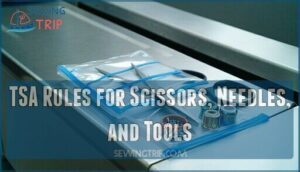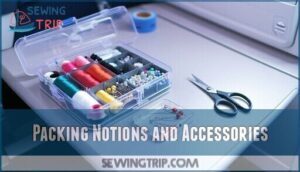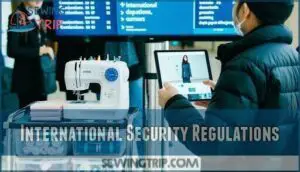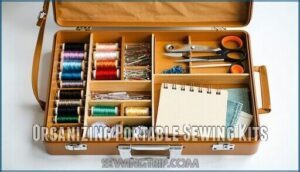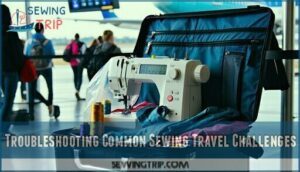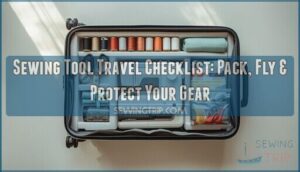This site is supported by our readers. We may earn a commission, at no cost to you, if you purchase through links.
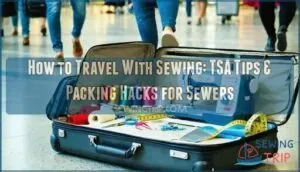
Your sewing machine can travel carry-on if it meets size limits (typically 22x14x9 inches, 22 pounds) or go checked with proper protection. Use original packaging with foam inserts or quality travel cases. Put the presser foot down and raise the needle before packing. Mark cases as "FRAGILE" and consider travel insurance.
The secret lies in knowing which projects work best for cramped airplane seats.
Table Of Contents
Key Takeaways
- You can bring most sewing supplies in carry-on – scissors under 4 inches, needles, pins, and thimbles pass through TSA, but pack sharp tools in clear bags and label containers for smoother security checks.
- Your sewing machine travels best with proper protection – use original packaging with foam inserts, put the presser foot down on fabric, raise the needle, and stay within airline size limits (typically 22x14x9 inches, 22 pounds for carry-on).
- Pack smart for cramped spaces – choose travel-friendly projects like hand embroidery or small patchwork blocks, organize supplies in compartmentalized cases, and consider rolling carts for easy transport through airports.
- Prepare thoroughly for sewing retreats – create detailed checklists divided into essentials, project materials, and organizers, then research destination rules and pack backup supplies in separate bags to avoid project shutdown.
How to Safely Travel With a Sewing Machine
Traveling with your sewing machine doesn’t have to stress you out if you know the right approach. Whether you’re heading to a quilting retreat or moving cross-country, proper preparation will keep your machine safe and security checks smooth.
Choosing Carry-on Vs Checked Baggage
Choosing carry-on over checked baggage gives you control over your machine’s safety. Most airlines allow sewing machines in carry-on luggage within standard baggage size limits, though weight limits may challenge heavier models.
Here’s your decision breakdown:
- Carry-on protection – You’ll personally handle your machine, avoiding rough baggage handlers.
- Checked bag fees – Save $35+ per flight with free carry-on allowances.
- Travel insurance options – Cover up to $1,500 for checked baggage damage claims.
- Carryon restrictions – Verify your machine fits airline dimensions before departure.
- Luggage protection tips – Use original packaging regardless of your choice.
When traveling, consider investing in durable sewing machine cases to protect your equipment.
Size and Weight Restrictions
Most airlines cap carry-on sewing machines at 22 x 14 x 9 inches with a 22-pound weight limit. Your machine’s case weight counts toward this allowance, so weigh everything together first. Checked bags allow heavier machines but risk damage during handling. To minimize damage, consider using proper packaging methods when transporting your sewing machine.
| Baggage Type | Size Limit | Weight Limit | Best For |
|---|---|---|---|
| Carry-on | 22" x 14" x 9" | 22-25 lbs | Portable machines |
| Checked | Varies by airline | Up to 50 lbs | Heavy machines |
| International | Verify with carrier | Often stricter | All destinations |
| Oversize | Special handling | Extra fees apply | Large quilting machines |
| Personal item | Under seat fit | Usually 15 lbs | Mini machines only |
Protecting Your Machine During Transit
Your sewing machine deserves first-class treatment during travel. Use the original manufacturer’s box with foam inserts for maximum protection—it’s specifically designed as shock absorbers for your model. Invest in quality sewing machine travel cases with secure packaging features.
Treat your machine like the treasure it is—proper protection prevents heartbreak at baggage claim
Put the presser foot down on fabric and raise the needle to prevent internal damage. These simple steps transform fragile portable sewing equipment into carryon luggage that survives turbulence.
Declaring and Labeling as Fragile
Travel insurance can be a lifesaver when transporting your precious sewing companion. Mark your sewing machine travel cases with bright "FRAGILE" stickers—they’re like red flags for baggage handlers. Whether choosing carryon luggage or checked baggage, proper labeling requirements help prevent damage.
Airlines appreciate clear fragile item handling instructions, and shipping precautions apply even for air travel regulations. Your machine deserves VIP treatment during its journey.
When preparing for air travel, consider the sewing machine rules to guarantee a smooth trip.
What Sewing Supplies Can You Bring on a Plane?
Knowing what sewing supplies you can pack makes the difference between a smooth airport experience and watching security confiscate your favorite scissors. You’ll need to understand TSA rules and pack strategically to keep your essential tools with you throughout your journey.
TSA Rules for Scissors, Needles, and Tools
Know the rules before packing your sewing arsenal. TSA allows scissors under 4 inches from the pivot in carry-ons, but anything longer goes in checked baggage. **Sewing needles, pins, and thimbles breeze through security without restrictions.
** However, TSA officers hold final authority and can confiscate items they deem risky.
Pack tools in clear bags and label containers as "sewing supplies" for smoother checkpoint experiences. **Understanding TSA sewing rules is vital for a stress-free travel experience.
Packing Notions and Accessories
Your sewing kit’s success depends on smart organization. Pack Sewing Kit Essentials like portable threads, mini notions, and a Simple Sewing Kit in clear accessory cases for easy security screening. Most Sewing Items Allowed include thimbles, safety pins, and tape measures.
Remember, carryon luggage restrictions apply to thread scissors over four inches, so choose travel-friendly options. A well-stocked sewing kit usually includes basic sewing kit essentials to handle various sewing tasks.
International Security Regulations
Different countries have their own security rules that can catch you off guard at border crossings. While TSA allows most sewing supplies, international airports might confiscate items that sailed through American security checkpoints. You’ll face stricter scrutiny with electronic devices like your machine.
- Research destination customs forms – Some countries classify sewing machines as restricted tools requiring special documentation
- Pack clear organization bins – Airport screening goes faster when officers can easily identify your supplies without digging through bags
- Prepare for language barriers – Security checkpoint staff may not recognize sewing equipment, so bring photos or translated explanations of your gear
To make a smooth trip, it’s vital to check the travel guidelines for sewing machines before heading to the airport.
Packing Tips for Sewing Projects on The Go
Smart packing turns any trip into a chance to create something outstanding. You’ll want to organize your supplies, pick projects that won’t drive you crazy in cramped spaces, and use the right bags to keep everything neat and accessible.
Organizing Portable Sewing Kits
Smart organization starts with compartmentalized storage—think tackle boxes or craft cases with built-in dividers. Group your Sewing Kit Essentials by function: threads together, Mini Sewing Tools in one section, pins in another. Clear containers let you spot what you need instantly. Include fabric scissors, seam ripper, needles, and portable projects supplies in your travel case. Don’t forget Compact Fabric Storage for scraps and a small notebook for quick project notes.
Effective sewing room organization tips, such as using efficient fabric storage, can also be applied to portable sewing kits to enhance space and productivity.
Selecting Travel-Friendly Projects
When choosing portable projects for your travel adventures, think small and simple to keep your sanity intact. Project size matters most—you don’t want to wrestle with a king-sized quilt in airplane seats!
- English Paper Piecing – Perfect for sewing on the go with minimal fabric choice requirements
- Hand embroidery projects – Low project complexity, high portability focus
- Small patchwork blocks – Manageable project size for various skill levels
- Binding preparation – Ideal travel sewing tips for finishing touches
- Appliqué work – Lightweight sewing projects with excellent portability focus
Using Rolling Carts and Storage Bags
Rolling carts and storage bags transform your sewing adventures from chaotic lugging sessions into smooth operations. A sturdy trolley case with quality wheels beats dragging heavy supplies through airports. Your travel sewing kit deserves a reliable travel bag that won’t leave you stranded with broken zippers mid-journey. When selecting a cart, consider the benefits of rolling sewing carts for improved mobility.
| Cart Options | Bag Materials | Storage Solutions |
|---|---|---|
| 4-wheel spinner trolley | Durable canvas | Multiple compartments |
| 2-wheel pull cart | Waterproof nylon | Expandable sections |
| Collapsible frame | Reinforced polyester | Clear pockets |
| Rolling tote hybrid | Leather accent trim | Zippered dividers |
| Wheeled duffel | Ripstop fabric | Removable organizers |
Wheel Durability matters most when traveling over cobblestones or through airport terminals. Look for Handle Designs that telescope smoothly and lock securely. Your travel case should fit overhead bins while protecting delicate notions. Smart carryon choices mean accessing your supplies without unpacking everything at security checkpoints.
Preparing for Sewing Retreats and Vacations
The key to a successful sewing retreat lies in thorough preparation—create detailed checklists for both your projects and packing essentials to avoid that sinking feeling when you realize you’ve forgotten your seam ripper halfway through your first block. Whether you’re heading to a weekend quilting getaway or planning a craft-focused vacation, organizing your supplies ahead of time transforms potential stress into creative bliss.
Creating Project and Packing Checklists
Creating your travel sewing kit starts with a solid checklist that prevents forgotten essentials. Divide your list into three sections: Sewing Kit Essentials like needles and thread, Travel Project Planning materials including pre-cut fabrics, and Portable Sewing Organizers such as your travel case.
This Checklist Management approach transforms chaotic packing into organized Sewing Retreat Preparation, giving you freedom to focus on creativity instead of logistics.
Must-Have Items for Quilt Retreats
Once you’ve organized your packing checklist, focus on gathering the right supplies for a successful retreat experience. Your Sewing Kit Essentials and Portable Sewing Tools can make or break your quilting adventure.
Here’s what seasoned retreat-goers always pack:
- Sew Together Bag with basic notions – thread, pins, seam ripper, and small scissors
- Travel Case for rotary cutters and rulers (pack sharp tools in checked luggage)
- Portable projects with pre-cut fabrics and clear instructions
- Retreat Organization Tips notebook with project notes and cutting measurements
Troubleshooting Common Sewing Travel Challenges
Even seasoned sewers hit snags when traveling with their machines and supplies. You’ll face everything from confused TSA agents to forgotten essentials, but these challenges have simple solutions once you know what to expect.
Handling Security Checkpoints
Security checkpoints can feel intimidating when you’re traveling with sewing machines, but knowing what to expect helps you breeze through. Remove your machine from its bag for separate screening, just like laptops. Declare it upfront to TSA agents—this speeds things up and shows you’re prepared.
Expect chemical swab tests and power cord inspections. Pack sharp tools in checked baggage to avoid confiscation headaches.
Preventing Damage and Loss
Machine protection starts with smart packing choices. You’ll want a sturdy travel case or Pelican box for checked baggage – your sewing machine’s survival depends on it. Travel insurance covers expensive equipment loss, while fragile handling labels alert baggage crews.
Security precautions include removing loose parts and securing the needle position. Damage prevention means using original foam padding and avoiding overstuffed bags.
When traveling by air, checking the airline sewing rules is essential to guarantee a smooth journey with your sewing machine.
Solutions for Forgotten or Lost Items
Forgotten supplies happen to the best of us. Pack Travel Backups like extra needles and thread in separate bags to avoid total project shutdown. Consider Item Insurance for expensive machines, and research local fabric shops at your destination beforehand.
- That sinking feeling when you realize your rotary cutter’s blade is back home
- The panic of discovering your favorite scissors didn’t make it through Airport Security Tips
- Relief flooding over you when Emergency Kits save your retreat project
Frequently Asked Questions (FAQs)
Can I bring sewing scissors in my carry-on bag?
Picture those familiar silver blades glinting in your sewing kit. You can bring small scissors under 4 inches in carry-on, but TSA might confiscate them anyway. Pack dull-tipped ones to minimize hassle.
What are some alternatives to flying with a sewing machine?
You can ship your machine ahead, rent one at your destination, or drive instead. Many quilting retreats provide machines, and some fabric shops offer rentals for temporary projects.
Are there any restrictions on bringing sewing machine needles on a plane?
Threading the needle on airline rules can be tricky. You can’t bring sewing machine needles in your carry-on – they’re considered sharp objects.
Pack them in checked baggage instead to avoid confiscation at security checkpoints.
How do I pack my sewing machine in a travel bag?
Use your machine’s original box and foam padding for maximum protection.
Put the presser foot down on fabric, keep the needle up, and pack the power cord separately for easy access.
Can I bring a portable sewing machine as a carry-on item?
Like packing your creative freedom in a suitcase, you can absolutely bring your portable sewing machine as carry-on.
Check airline size and weight limits first, keep it in original packaging, and put the presser foot down on fabric for protection during your journey.
Can I bring my serger on flights?
Yes, you can bring your serger on flights as carry-on luggage. Check airline size and weight limits first.
Pack it in its original box with foam padding, and remove all needles for security screening.
How do airlines handle overlock machine accessories?
Before telegraphs connected distant shores, seamstresses packed their treasured tools carefully.
Airlines treat serger accessories like regular sewing supplies—you’ll pack cutting blades and needles in checked luggage, while thread, bobbins, and smaller notions can fly with you in carry-on.
What about traveling with embroidery hoops internationally?
Embroidery hoops pack easily in carry-on bags since they’re usually wooden or plastic circles without sharp edges. International security rarely flags them, but you’ll breeze through checkpoints faster than threading a needle.
Are quilting rulers allowed in carry-on bags?
Walking on thin ice with security? Quilting rulers usually pass TSA screening since they’re not considered sharp objects. However, metal rulers might trigger extra inspection. You’ll breeze through with acrylic rulers under 12 inches.
Can I pack fabric glue in luggage?
Fabric glue falls under liquid restrictions, so you’ll need to follow the 3-1-1 rule for carry-ons.
Pack larger bottles in checked luggage instead. Small travel-sized tubes work fine for carry-on bags.
Conclusion
Picture yourself stepping off the plane, your trusty sewing machine in tow, ready to create memories stitch by stitch. Mastering how to travel with sewing paves the way to retreats, workshops, and creative adventures worldwide.
You’ve learned the TSA rules, packing strategies, and troubleshooting tricks that’ll keep your supplies safe. Whether you’re heading to a quilting retreat or vacation with a portable project, you’re equipped to handle any travel challenge.
Pack smart, travel confidently, and let your creativity flourish wherever the journey takes you.
- https://yarnery.com/products/travel-sewing-kit
- https://www.tsa.gov/travel/security-screening/whatcanibring/items/sewing-needles
- http://thenotsodramaticlife.com/sew-on-the-go-packing-a-sewing-kit/
- https://www.fortheloveofthread.com/blog/prepare-the-perfect-travel-sewing-kit
- https://easythingstosew.com/sewing-needles-on-a-plane/

